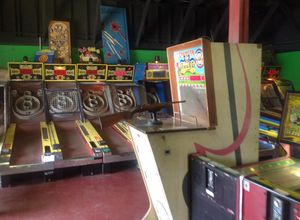Arcade

| |
| Arcade | |
| Developer | Numerous |
|---|---|
| Publisher | Numerous |
| Platforms | See arcade hardware |
| Released | 1902-present |
| Added to Museum |
N/A |
An arcade, also known as an amusement arcade, video arcade, or game center, is a location that has coin-operated games to play. They can be a dedicated arcade location or consist of one or more coin-operated games inside a business such as a bar or a restaurant.
History
The earliest arcades were called penny arcades, as pennies were the original currency used in coin-operated games. The earliest use of the term in print appeared in the May 17, 1902 edition of The Saint Paul Globe newspaper in Saint Paul, Minnesota in the United States of America. The penny arcade at Eldridge Park in Elmira, NY first appeared in print in the April 9, 1923 edition of Star-Gazette. It was one of the longest continuously running arcades in the world when Eldridge Park closed in 1989.
The games played in the penny arcades were non-electrical, and some scored points or performed tasks through mechanical means while others were manual. The most popular penny arcade games included:
- Bagatelles (a billiards game developed in France in 1777 in which the goal is to get a set number of balls past stationary pegs into holes guarded by also guarded by stationary pegs). The version popular in penny arcades incorporated these changes to the game:
- In 1871, the English-American inventor Montague Redgrave was awarded a patent for improvements to bagatelles that replaced the billiards cue with a spring-loaded plunger, decreased the size of the game so that it would fit atop a counter, changed the balls from billiard balls to marbles, and changed large wooden pegs to small metal pins.
- coin-operated fortune telling machines
- Coin-operated music players:
- music boxes
- player-pianos
- jukeboxes
- Amberolas that played wax cylinder records (Blue Amberol Records were introduced in 1912, replacing the 4 minute Black Amberol Records introduced in 1890, that in turn replaced the wax cylinders introduced in 1888)
- Phonographs that played records (vinyl records were introduced in 1931, replacing shellac records that were introduced in 1895)
- Later jukeboxes used cassette tapes, compact discs, or digital media such as MP3 (MPEG-1 (Moving Picture Experts Group) and MPEG-2 Audio Layer III) files.
- Coin-operated shooting games
- Mutoscopes (early machines that displayed motion pictures in a similar method as flipbooks)
- Pachinko and pinball games, derived from bagatelles.
- Pin games evolved into the game commonly known as pinball with the addition of electromechanical games with active bumpers in 1933 and with the addition of flippers in 1947.
- Pinball machines began using microprocessors in 1976.
- Pachinko games only used electricity for lighting, until roughly this time, when some began to have electromechanical features and/or microprocessors.
- Peep show machines (non-pornographic photographs and pictures shown through the machine)
- Slot machines